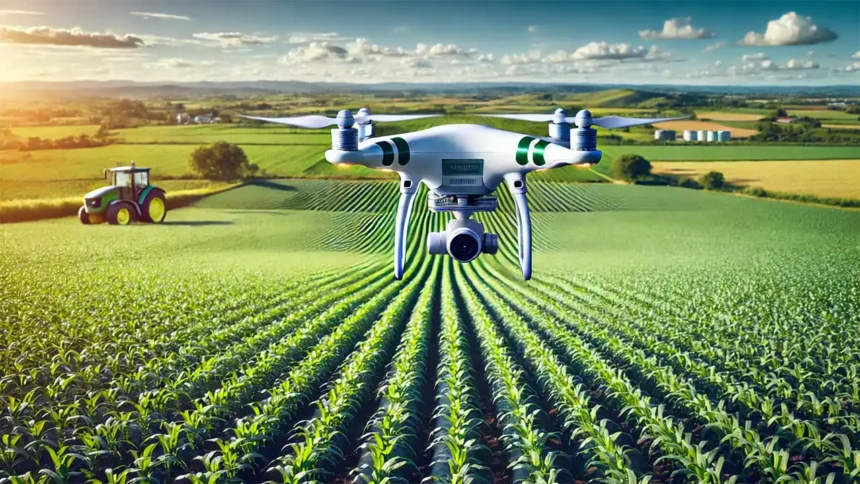Drone Camera for Agricultural Use: A Comprehensive Guide to Farming with Drone Cameras
Drone cameras are rapidly transforming modern agriculture, giving farmers innovative tools to monitor, manage, and optimize crop production. With the use of drones, farmers can access real-time aerial views, identify crop health issues early, and improve the efficiency of farm management practices. This technology, often termed “precision agriculture,” offers numerous benefits, from enhancing crop yield to reducing labor costs and promoting sustainable farming. This post explores Drone Camera for Agricultural Use and their types, benefits, and factors to consider before investing in one.
What are Drone Cameras in Agriculture?
Drone cameras are unmanned aerial vehicles (UAVs) equipped with cameras and sensors, specifically designed to assist in farming tasks. These drones can capture high-resolution images and data, allowing farmers to make well-informed decisions. Equipped with various sensors, drone cameras collect information about crop health, soil conditions, water management, and more, making them a vital tool in precision agriculture.
Key Types of Agricultural Drone Cameras
There are several types of cameras used in agricultural drones, each serving unique functions:
- RGB Cameras: These standard cameras capture visible light, producing high-resolution images used for basic surveying and mapping. RGB cameras are helpful for land assessments and planning.
- Multispectral Cameras: These cameras capture data in both visible and invisible light spectrums, including infrared. Multispectral imagery is crucial for generating Normalized Difference Vegetation Index (NDVI) maps, which help detect crop health issues.
- Thermal Cameras: Thermal cameras detect temperature differences and are often used to monitor water levels, identify irrigation problems, and detect pest infestations based on heat variations in the field.
- LiDAR Sensors: LiDAR (Light Detection and Ranging) sensors create precise 3D maps of the landscape, useful in assessing terrain features, crop density, and land topography.
Applications of Drone Cameras in Agriculture
1. Crop Health Monitoring
Drones with multispectral or thermal sensors help monitor crop health throughout the growing season. By detecting early signs of diseases or pest infestations, farmers can quickly address issues before they spread, ensuring healthier crops and better yields.
2. Soil Analysis and Preparation
Drone cameras are used to survey soil properties before planting, assessing factors like moisture levels, organic content, and soil erosion. This data helps farmers optimize land preparation and choose appropriate crop varieties.
3. Irrigation Management
Thermal imaging from drones helps identify areas of water stress or drainage issues in fields. Farmers can use this information to adjust their irrigation systems, saving water and ensuring that all plants receive adequate moisture.
4. Fertilizer Application
By analyzing crop health, drones can identify areas with nutrient deficiencies, helping farmers apply fertilizers more precisely. This targeted approach reduces waste and environmental impact while promoting balanced plant growth.
5. Livestock Monitoring
Drones can also assist in livestock management by tracking animal locations, ensuring that herds are safe and healthy, especially on large farmlands. They can identify injured or ill animals by detecting unusual behavior or movement.
Advantages of Using Drone Cameras in Agriculture
- Increased Efficiency: Drones enable fast data collection over large areas, allowing farmers to monitor and assess crops without extensive manual labor.
- Cost-Effective: By identifying issues early, drones reduce the need for excessive pesticide or fertilizer applications, which can lower overall operational costs.
- Improved Crop Yields: Drones provide actionable insights that help farmers optimize crop health, resulting in higher and more consistent yields.
- Environmental Sustainability: Precision agriculture enabled by drones minimizes resource use, reducing the environmental impact of farming practices.
- Enhanced Safety: Using drones to survey fields and monitor livestock decreases the need for farmers to enter potentially hazardous areas, promoting farm safety.
Choosing the Right Agricultural Drone Camera
Selecting the right drone for agriculture requires considering factors such as budget, farm size, and the specific tasks it will perform:
- Purpose and Use: Different cameras serve different purposes. Multispectral and thermal sensors are ideal for crop health monitoring, while LiDAR is useful for topographical surveys.
- Flight Time and Coverage: Fixed-wing drones offer longer flight times and cover larger areas, making them suitable for extensive farmlands. Rotary-wing drones are ideal for smaller areas due to their flexibility and precision.
- Camera Resolution: High-resolution cameras capture more detailed images, providing accurate data for analysis.
- Ease of Use: Look for drones with user-friendly software and autonomous features that simplify operations.
- Data Processing and Integration: Choose a drone with software that integrates well with existing farm management systems for seamless data processing.
Challenges of Using Drone Cameras in Agriculture
- High Initial Investment: Although drones offer long-term savings, the upfront cost can be significant, especially for high-tech models with multispectral or thermal cameras.
- Regulatory Constraints: In some regions, the use of drones in agriculture is regulated, requiring permits or operator certification.
- Data Management: The data generated by drones can be overwhelming without proper processing tools, which may require additional investment in software and training.
- Weather Limitations: Drones are sensitive to weather conditions, and flights may be delayed during heavy rain, wind, or extreme temperatures.
- Battery Life: The limited battery life of drones restricts their coverage area, especially for large fields. Investing in extra batteries can help but adds to the cost.
Future of Drone Cameras in Agriculture
The future of drones in agriculture is promising, with emerging technologies like artificial intelligence (AI) and machine learning further enhancing their capabilities. AI-powered drones can predict crop yields, detect diseases at early stages, and automate field inspections. Integration with the Internet of Things (IoT) is also expected to make data collection and management more streamlined, making drones an indispensable tool in smart farming.
Conclusion
Drone cameras have undeniably revolutionized agriculture by offering precision, efficiency, and sustainability. With their advanced sensors and imaging technology, drones allow farmers to monitor crop health, manage resources effectively, and optimize farm productivity. Despite challenges such as cost and weather sensitivity, the benefits make drones a worthwhile investment for modern agriculture. As technology advances, drones will continue to play a pivotal role in ensuring food security and promoting sustainable farming practices worldwide.
FAQs
What types of cameras are used in agricultural drones?
Agricultural drones use RGB, multispectral, thermal, and LiDAR cameras, each serving unique functions such as monitoring crop health, analyzing soil, and managing water resources.
How do drones help in crop monitoring?
Drones capture detailed aerial images and data, allowing farmers to detect early signs of disease or pest infestations, optimize fertilizer application, and manage irrigation.
Are agricultural drones expensive?
While initial costs can be high, drones often result in long-term savings by reducing waste and improving crop yields.
What factors should I consider before buying an agricultural drone?
Consider the drone’s purpose, flight time, camera resolution, ease of use, and data processing capabilities.
Can drones be used for livestock monitoring?
Yes, drones are used in livestock monitoring to track animal locations, detect injuries or illness, and ensure overall herd safety.





